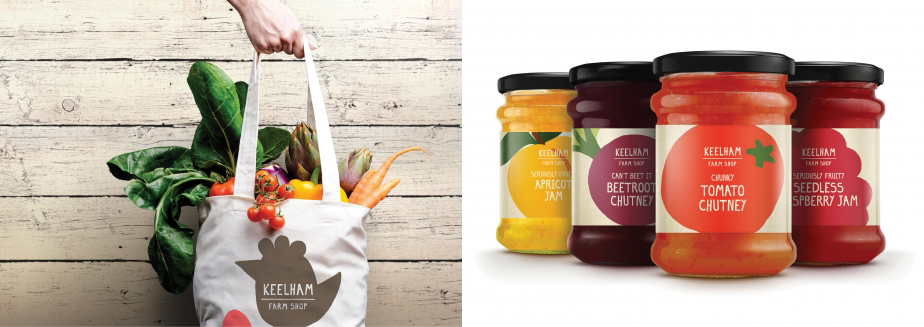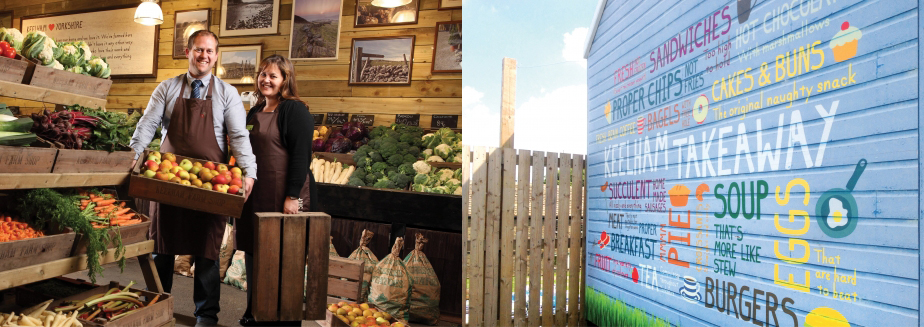How to achieve trust – a key aspect of the designer/client relationship
The DBA’s John Scarrott looks at how to build trust in a client relationship, using the example of the award-winning work by Thompson Brand Partners for Keelham Farm Shop.

Assuming that the success of a design project depends largely on the quality of the designer/client relationship, what are the criteria for such relationships and how might designers and clients cultivate these qualities in their relationships to positive effect?
Trust seems like a good place to start and I caught a glimpse of how this quality works within a relationship during the Design Effectiveness Awards last month. It came from Ian Thompson, head of Thompson Brand Partners who, with Victoria Robertshaw, joint owner of Keelham Farm Shop, collected a Gold Award.
At the awards, winning agencies and clients get to go up on stage where a short interview takes place. During this interview, Ian commented: “There’s nothing like a client’s trust to make you up your game.”
This quote struck me as really interesting. It hinted at the interrelationship between client and designer, how the dynamic is not just about money and work passing in opposite directions. It suggested a level of dynamism and energy underpinning the relationship that, when understood and tapped into, has the potential to generate performance improvements for both parties and make the relationship really fulfilling.
I wanted to explore the source of this energy, to try and find out how it was created and start to place it into a map that could be useful to designers and clients looking to develop more successful relationships. I spoke first with Ian Thompson and then Keelham’s Victoria Robertshaw. Their descriptions of how trust works in their relationship sheds light on how this contributes to their success.
Here’s what they told me, followed by some pointers on what other designers and clients might do to achieve the same success.
A bump in the road is the perfect base on which to build trust
After a good start, the relationship between Thompson and Keelham hit a bump in the road. This bump was an opportunity in disguise. For Victoria it gave her the chance to look at other consultancies. For Ian it was the chance to review what had happened. He took a step back and wrote an honest letter to Victoria to say he was sorry it hadn’t worked out. Victoria’s experience with her new consultancy made her re-evaluate the quality of her relationship with Thompson. The new consultancy didn’t feel quite right. Ian and Victoria met up. For Ian their conversation made him more mindful of what the relationship was like for the client. Victoria realised she liked the way Thompsons worked and gradually they started to move back towards working together.
The client and designer build each other’s confidence
When Keelham wanted to implement new brand work on its Thornton shop, it asked Thompson to do the retail design. Thompson is a brand consultancy so this was not in its usual skill set. Taking on this work found it going outside what they would typically work do. Ian was honest and said so. Victoria’s response was simply: “Yes, you can do it. You are capable.” When Ian needs help from specialists he gets it. But Victoria trusts Thompson to be sat alongside her at the top table, “thinking brand”.
Ian and his team take Victoria through their thought process. “We show some unfinished ideas. We trust Victoria not to judge us on these ideas and she is comfortable with this. We present our workings. We’re not working to our agenda, it’s about what’s important to Keelham. If anyone at Thompson doesn’t know something, they hold their hands up. Our approach is about being open and honest; truth and trust go hand in hand.”
The designer needs to get the client and the client needs to feel “got”
For Victoria, “Ian just gets Keelham. He thinks of things that we haven’t thought of but are still right for us”. A good example of this is that Keelham has blackboards along the road that they put together themselves to make their customers driving along smile. They are part of Keelham’s pre-Thompson identity. When Thompson put together the visual ID it took inspiration from these boards for Keelham’s fonts. A small thing, you might think. But crucially important, because when a change is proposed to anyone for anything, it will be more likely to be adopted if it borrows something that they already feel close to. In that way, the change is in them already, it feels natural, not forced.
The importance of “thinking harder” to Keelham and Thompson
For Keelham, it was thinking about values. Keelham has been going since the 1920s. It was Victoria’s Grandad’s business, which her Dad built on in in 1970 when he opened the farm shop and then Victoria with her brother James in 2006. Keelham started to grow but there was no management structure, Victoria found that people were not making the right decisions. “They won’t get our values by osmosis. We need to get them down on paper as much now as for the future. So Keelham would continue.” This was a hard process and initially they did not get finished. But we need them. They are a framework to make decisions. As long as you’re doing that, then you’re doing the right thing.”
For Thompson it was about not stopping at the obvious. As part of a refurbishment of Keelham’s place in Thornton the consultancy looked at staff uniforms. It went to uniform suppliers who came back with ideas that were, to be frank, pretty uniform. Thompson thought about it and suggested they go for something more eclectic, interesting and on-brand. And it was cheaper. The idea came about from thinking harder about the question to get to a better answer.

What can designers and clients take from these examples?
They could swap their values up front. If your value system is the one that guides your decision-making, perhaps both parties should be sharing their values ahead of starting work. “Can you tell me about your values?” should be one of the early questions. As a client you will feel understood. You’ll be able to talk to your values. As a designer you’ll be able to understand and pitch the right idea from the start. From this point you both have a better chance of moving outside of your comfort zones together.
Designers to include their client in the idea, clients to look for themselves in the idea. As a designer, when you suggest an idea, check to see where it has come from and what is included from the client’s present positive situation in the execution. As a client look for yourself in the idea. Look for what’s right, not for what’s wrong.
Clients and designers to work hard to create and refine their values. Victoria has a monthly gathering where she welcomes new employees and goes through the values. She has workshops where these are explored. These are the places where the values have evolved and distilled. For example:
“Taste…. a paragraph of text” became “Taste comes first.”
“Affordability… everyone should have great food every day” became “For everyone.”
“Fairness… a paragraph about the history of the business” became ‘Just do the right thing”.
Both parties to rethink failure. See failure as an opportunity to create a strong memory of who you are and what you do. As Ian puts it: “The way someone fixes a problem is a measure of them. Life is not clean and simple but you have to act fast, act decisively and go to the ends of the earth to fix the problem.” For clients, listen to your agency. Assess whether it’s a blip rather than the relationship failing.
It’s all about the people. Trust is about saying and doing. So this means making sure that everyone gets to meet everyone that will be saying and doing. This applies equally to clients and their agencies.
John Scarrott is membership director at the Design Business Association. He Tweets at @DBAScarrott.
-
Post a comment




